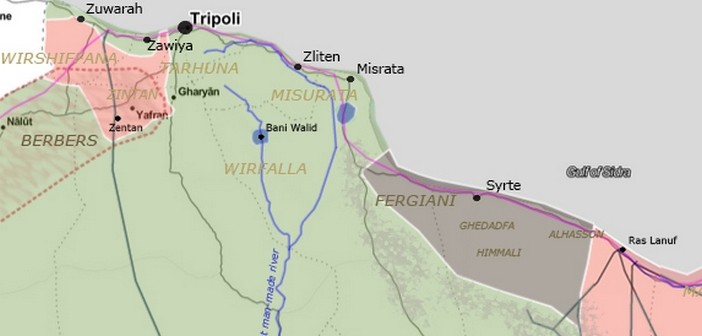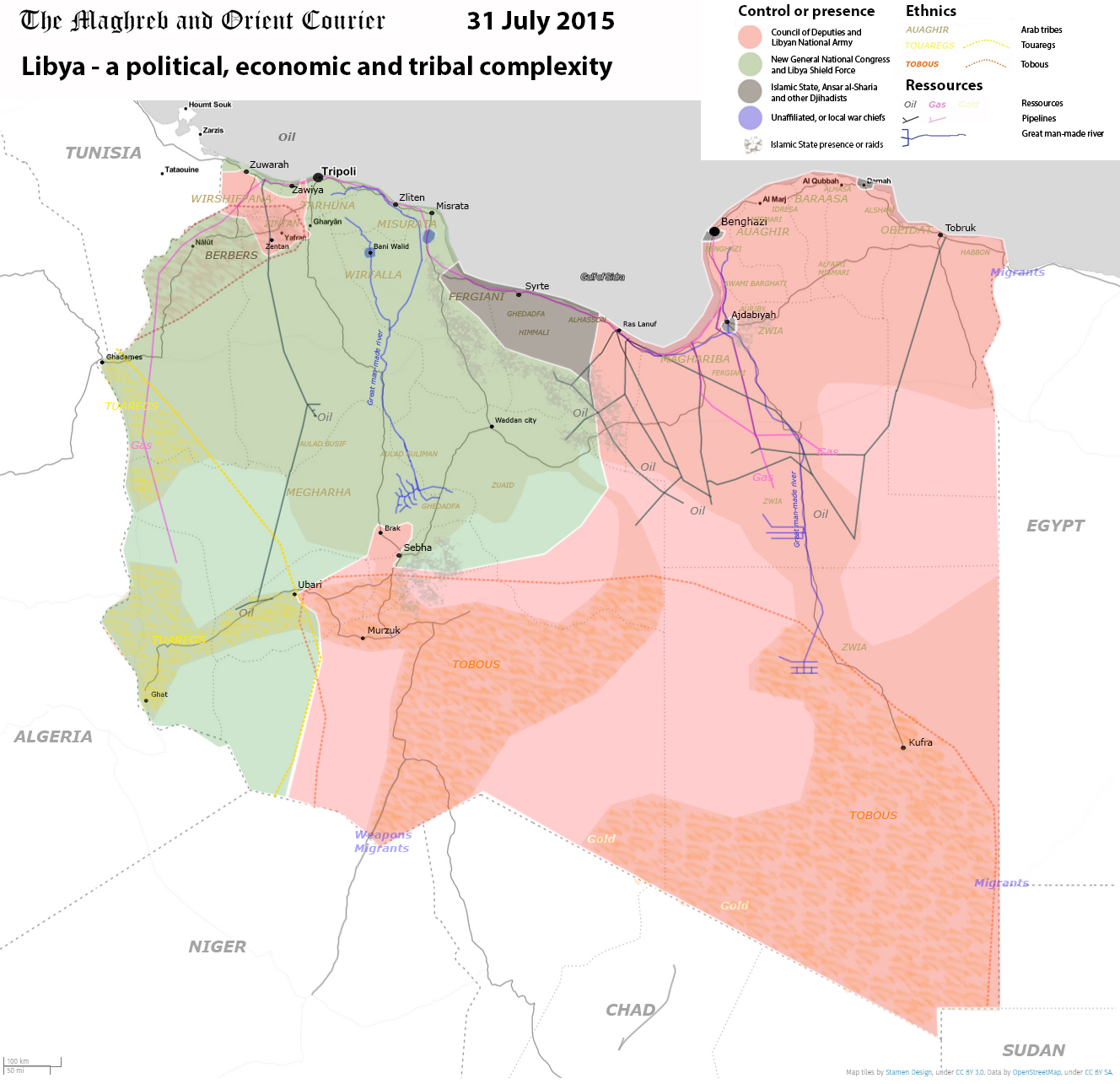When looking at the current situation in Libya, one has to admit it is hardly understandable: Two governments, hundreds of tribes and autonomous armed groups, and the growing presence of competing jihadists groups amongst which the local Islamic State. This article attempts to give an overview of today’s situation in Libya, and to highlight a few important factors, such as the control of the economic resources.
Two governments fighting for legitimacy
There are currently two governments claiming legitimacy over the whole country. Both are issued from the General National Congress.
One is known as the “Tobruk Government”, internationally recognized, and composed of the Council of Deputies elected in June 2014, whose chairman is currently Aguila Saleh Issa. However, these elections where triggered by Khalifa Haftar, now commander of the Libyan armed forces (LNA) who wished to overthrow the former Islamist majority. This led to a coup by those same Islamists (operation Libyan Dawn), in August 2014 in Tripoli, forcing most members of the elected council to relocate to a safer area in Tobruk near the Egyptian border.
The Tobruk government is backed by the Lybian National Army (LNA) and General Khalifa Haftar, as well as other armed factions such as the Zintan brigades, the Tobous militias, or the Petroleum facilities guards (PFG). In addition to its international recognition, it is also supported by Egypt and the United Arab Emirates.
The Tobruk government mainly controls the East of the country: Cyneraica, with the exception of some Jihadist-controlled pockets, most of the oil fields south of Ras Lanuf and Ajdabiya, the South, South-East desert and Kufra area with the help of the Tobous militias, and the Zentan area South-West of Tripoli, a mostly Berber zone controlled by the powerful Zentan brigade.
The other is the new General national congress “NGNC” appointed by the Islamist factions following the operation Libyan Dawn. The NGNC voted themselves as a replacement of the Council of Deputies, elected in June, with Tripoli as their political capital, Nouri Abusahmain as president and Omar al-Hasi as prime minister
The NGNC is backed by the Libyan Dawn (Fajr Libya) military coalition, a group of Islamist militias including the strong Misrata brigade, the Libya revolutionaries’ operation room, and the Amazigh (Berbers) and Tuareg militias. The NGNC is supported by the Muslim brotherhoods, Qatar, Sudan and Turkey.
The NGNC controls the Tripoli area, Misrata, as well as most of the West of the country, with the help of Amazigh and Tuareg militias. The situation is more complicated in the Southern city of Sebha, disputed between both governments via several militias and with an increased presence of the Islamic State.
Islamic State and other Jihadists
The Islamic State has been developing mainly in the Northern central area of Sirte where it recently extended its rule to nearby towns and regularly launched raids toward the West and the Oil fields in the South. It is also present in Fezzan, Cyrenaica, Benghazi and Derna. However, following recent fights with the local council of Mujahidin, they were expelled from that city.
Other Jihadist groups include Ansar al-Sharia, from which many defected to the Islamic State, Abu-Salim brigades, and other groups who constitute local Shura Councils, in Benghazi, Derna and Ajdabiyah.
Although fighting each other, the Islamic State and the local Shura councils share the same ideology.
Click on image to enlarge it
A tribal country
Every observer of Libya remembersSaif al-Islam(son of Mouammar Gaddafi) claiming on Libyan TV that “Libya is a tribal State!”. Well, he was very right, as the tribal and ethnic factors explain the fragmentation of the country.
There are hundreds of Arab tribes in Libya, and each of these tribes has it own agenda. Gaddafi’s ultimate refuge in Sirte could be explained by the strong support he had from his tribe located in that area. The divided situation in the strategic Ajdabiya city can be explained by the rivalry between Zwia and Maghariba tribes, as the first make up most of the recruits for the local revolutionary Shura council and the second are mostly in favor of the Tobruk government.
The Tobous follow a more liberal version of Islam, and are a strong supporter of the Tobruk government in the South, particularly challenging the Tuaregs in the oil rich town of Ubari. Meanwhile, the tensions between Tobous and Arab tribes in Kufra are strong.
The Tuaregs mainly follow their agenda in the South West of Libya. However, they support the Islamist NGNC and are strongly opposing the rival Tobous.
The Berbers (or Amazighs) are divided, as most of them chose to support the NGNC while the Zentan Berbers chose to support the Tobruk government. As a consequence, the Djebel Nefoussa is divided between both governments.
The control of resources
Most important is that all the factions are struggling for access to and control ofresources. Indeed, in a country where there is neither central administration nor any state service, everybody has to ensure their access to basic utilities, perhaps even by purchasing them. This necessity triggers the need to maintain well-equipped armies and militias, and this requiresgreat amounts of money.
Oil is certainly the main assetthe factions are fighting for. It is a complex game, as oil fields are operated by the National Oil Corporation (NOC), a company, which has kept a kind of neutrality in the conflict, but whose headquarters are based in NGNC-controlled Tripoli, therefore making them suspicious in the eyes of the Tobruk Government, which is currently creating a new NOC based in the East. However, the NOC does not guard the oil fields, this responsibility lieswith the Petroleum Facilities Guards (PFG), a para-military force allied with the Tobruk Government and with the Libyan National Army, but often sticking to its own agenda. In addition, the Islamic State has raided several oil fields in the recent months, killing or kidnapping employees, adding to the growing confusion in the Sirte – Ajdabiya area. The same struggle is also happening in the south between Tuaregs and Tobous, fighting for the control of those oilfields in the Ubari – Murzuq area.
Water is also a big issue in a country like Libya, covered mostly by desert. There are two gigantic projects named “Great man-made rivers” built during the Gaddafi era, consisting in pumping water into the desert. The water is routed by pipelines, one in the West, passing near Misrata and going to Tripoli, and the other in the East passing through Ajdabiya and continuing to the populated city of Benghazi. One can then understand the importance of a place like Ajdabiya where not only the water pipes go through, but also oil and gas. The Jihadists must have understood what is at stake by seizing important parts of that city, as well as the whole Sirte area (by the Islamic State), very close to the oil terminals and where Oil and Gas pipelines are supposed to fuel the West of the country.
The Touaregs not only have access to Oil and Gas fields; they also control two important roads, one going to the border with Algeria and Tunisia, in Ghadames, and another one going to Algeria via Ghat. These roads are used for different kinds of trade, including weapon smuggling to and from the Sahel.
The Tobous are also controlling two important roads. One is going to Niger and the border area being equipped with two small uncontrolled airports, it is widely used for importing weapons. The other road, allows to reach Sudan from Kufra, and is used by East Africa migrants. In addition, the Tobous are taking advantage of the Gold mining in the formerly named “Banded’Aozou”, a desert area bordering Libya and Chad.
In summary, the lack of a central authority, as well as the tribal fragmentation and rivalry, and the fighting for the economic resources has led to a complex political situation in which two weak governments are trying to obtain continuity and recognition, but in fact control nothing. Indeed, real control lies with the armed militias and private armies, which are giving their allegiance to one or the other government (or to the Islamic State), but also changing their allegiance depending on the military situation or on the economic opportunities.
In other words, Libya is entering a feudal-like era.





5 Comments
Egregiously inaccurate opening casts doubt over the rest of what seemed an interesting piece.
“One is known as the “Tobruk Government”,[THE GOV IS IN BEIDA – PARLIAMENT IS IN TOBRUK] internationally recognized, and composed of the Council of Deputies [HOUSE OF REPRESENTATIVES] elected in June 2014, whose chairman [PRESIDENT] is currently Aguila Saleh Issa. However, these elections where triggered by Khalifa Haftar, now commander of the Libyan armed forces (LNA) who wished to overthrow the former Islamist majority.[ HAFTER DID NOT TRIGGER THE ELECTIONS. THERE WAS NEVER AN ISLAMIST MAJORITY] This led to a coup by those same Islamists (operation Libyan Dawn), in August 2014 in Tripoli, forcing most members of the elected council to relocate to a safer area in Tobruk near the Egyptian border.
Pingback: Mapa actual de la situación política en Líbia (ENG)
Pingback: North Africa Media Roundup | Al Maghrib al youm
Pingback: Agathocle de Syracuse | ARAB WORLD MAPS (Libya) – political, economic and tribal complexity
Pingback: Don’t Be Hasty, Mr Setya Novanto – Mon Journal Intime